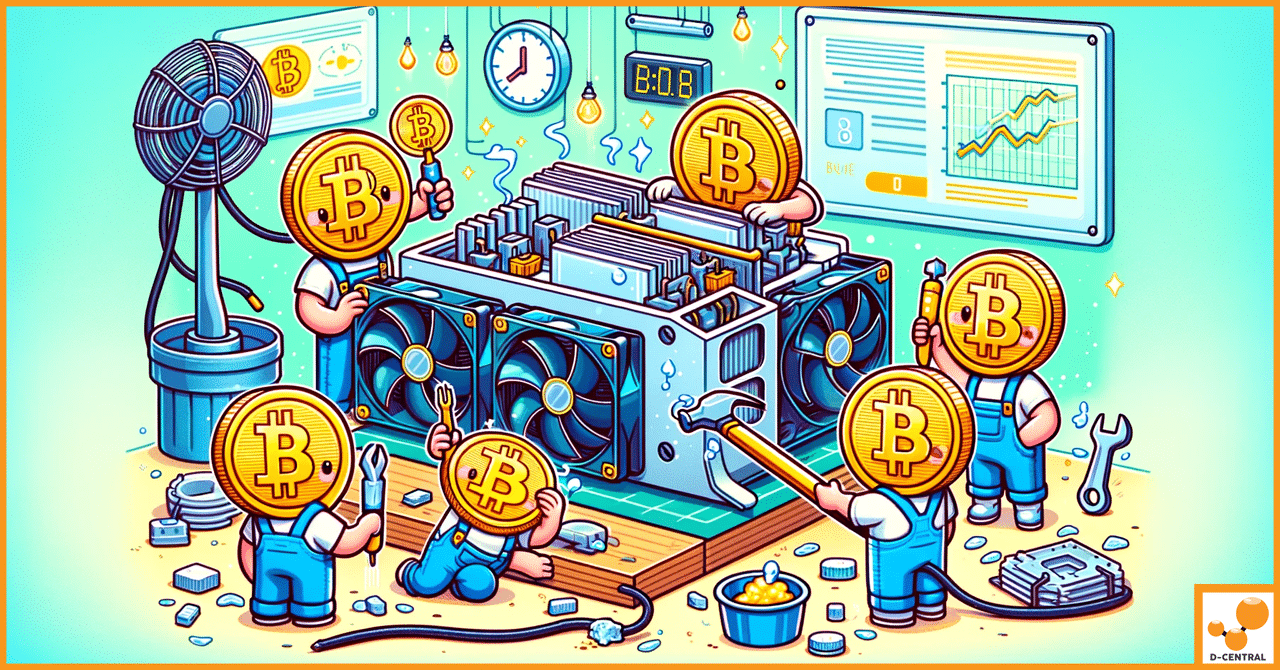
The Intersection of Bitcoin, Pokémon Cards, and the Lindy Effect
In a world constantly evolving with new ideas and technologies, understanding the dynamics that determine the longevity and relevance of
4479 Desserte Nord Autoroute 440, Laval, QC H7P 6E2

In the dynamic world of cryptocurrency mining, the Antminer S17+ has emerged as a cornerstone of efficiency and power. Manufactured by Bitmain, one of the leading producers of ASIC mining hardware, the Antminer S17+ is revered for its exceptional hash rate capabilities and energy efficiency, making it a prized asset for Bitcoin miners aiming to maximize profitability in a competitive landscape. This high-performance mining rig is designed to solve complex cryptographic puzzles, thereby securing the blockchain and minting new Bitcoin. Its role in the mining industry is not just significant; it’s transformative, offering a blend of power and efficiency that sets the standard for what miners expect from their hardware.
However, the formidable processing power of the Antminer S17+ comes with its own set of challenges, most notably in cooling. Effective heat management is crucial for maintaining optimal performance and extending the lifespan of mining equipment. Users of the Antminer S17+ often grapple with the common dilemma of overheating, which can lead to reduced efficiency, increased power consumption, and, in severe cases, hardware failure. The compact design and intense operational workload of the Antminer S17+ mean that it generates a substantial amount of heat, necessitating advanced cooling solutions to keep temperatures within safe operating limits.
Addressing this critical issue, the concept of a heatsink refit emerges as a potent solution. A heatsink is a passive heat exchanger that transfers the heat generated by an electronic or a mechanical device, thereby allowing regulation of the device’s temperature at optimal levels. In the context of the Antminer S17+, a heatsink refit involves upgrading or replacing the existing cooling system with a more efficient one, specifically designed to handle the rig’s high thermal output. This process not only enhances the cooling capacity but also contributes to improved miner performance, reduced risk of overheating, and a significant extension of the hardware’s operational life. By focusing on the heatsink as a pivotal component of the mining rig’s cooling system, miners can ensure that their Antminer S17+ continues to operate efficiently, reliably, and profitably in the fast-paced world of Bitcoin mining.
The Antminer S17+, a powerhouse in the realm of Bitcoin mining, operates under intense computational stress to decrypt cryptographic challenges, thereby validating transactions on the blockchain. This relentless processing not only underscores the rig’s pivotal role in cryptocurrency mining but also brings to light the critical need for efficient cooling mechanisms. The essence of cooling in such high-stake machinery cannot be overstated, as it directly impacts the performance, efficiency, and longevity of the hardware.
Cooling is the linchpin in maintaining the Antminer S17+’s operational integrity for several reasons. First, the ASIC (Application-Specific Integrated Circuit) chips within the Antminer S17+ are engineered to perform at their peak when kept within a specific temperature range. Excessive heat can throttle the processing capabilities of these chips, leading to a noticeable dip in hash rate and, consequently, mining efficiency. Moreover, consistent thermal regulation ensures that the Antminer S17+ operates within its optimal power efficiency parameters, preventing unnecessary energy wastage and keeping operational costs in check.
The repercussions of inadequate cooling extend beyond mere performance degradation. Overheating can precipitate a cascade of adverse effects, including:
The Antminer S17+ is equipped with a built-in cooling system designed to mitigate the thermal output of its high-intensity mining operations. This system typically includes high-speed fans and heat sinks that work in tandem to dissipate heat away from the ASIC chips and out of the miner’s chassis. While effective to a degree, this cooling solution has its limitations.
Firstly, the built-in system primarily relies on air cooling, which, while practical, may not suffice under all operational conditions, especially in warmer climates or poorly ventilated spaces. Additionally, the efficiency of air cooling diminishes as the ambient temperature rises, which can lead to suboptimal cooling during heatwaves or in naturally hot environments.
Secondly, the constant operation of high-speed fans to maintain temperature equilibrium introduces another layer of operational wear and tear, potentially leading to fan failures and necessitating frequent replacements. Moreover, these fans can be notably loud, posing a challenge for noise-sensitive environments.
In summary, while the Antminer S17+’s built-in cooling system forms the first line of defense against overheating, its limitations underpin the need for enhanced cooling solutions, such as a heatsink refit, to ensure the miner’s performance and longevity are not compromised by thermal challenges.
In the high-stakes world of cryptocurrency mining, where every hash counts towards the quest for Bitcoin, the role of efficient cooling cannot be overstated. Central to this cooling conundrum is the heatsink, a device that might seem simple at first glance but is pivotal in maintaining the delicate balance between performance and longevity of mining hardware like the Antminer S17+.
A heatsink is a passive cooling device that dissipates heat from a hotter object (in this case, the ASIC chips in a miner) to a cooler environment, usually the air surrounding it. It works on the principle of thermal conduction, where heat moves from a higher temperature area to a lower temperature one. The heatsink achieves this by increasing the surface area that is in direct contact with the air, allowing for more efficient heat transfer. This is often facilitated by fins or pins that extend from the base of the heatsink, creating pathways for heat to escape more rapidly than it would from a flat surface.
ASIC miners, such as the Antminer S17+, are compact units packed with ASIC chips that generate a significant amount of heat due to the intense computational work they perform. The role of a heatsink in these devices is crucial. It directly contacts the heat-generating components, drawing heat away from them and dissipating it into the surrounding air. This process helps maintain the ASIC chips at an optimal operating temperature, preventing thermal throttling, where the device’s performance is automatically reduced to prevent overheating, and protecting the chips from heat-induced damage that can shorten their lifespan.
Heatsinks come in various designs and are made from different materials, each with its properties and efficiencies in heat dissipation:
The choice of heatsink and material in an ASIC miner like the Antminer S17+ depends on several factors, including the specific heat dissipation needs of the device, the ambient operating conditions, and cost considerations. Upgrading to a more efficient heatsink or refitting an existing one can significantly enhance the cooling performance of the miner, ensuring it operates at peak efficiency and has a longer operational life.
Optimal cooling is paramount for the Antminer S17+ to function at its best. However, cooling systems may sometimes fall short, leading to inefficiencies that can significantly impact the miner’s performance and longevity. Recognizing the signs of inadequate cooling early can help mitigate potential damage and maintain your mining operation’s efficiency.
Monitoring your Antminer S17+’s operational metrics is crucial for identifying cooling inefficiencies:
A heatsink refit should be considered under several circumstances to ensure your Antminer S17+ continues to operate efficiently:
Recognizing the signs of cooling inefficiency and taking proactive steps to address them, such as considering a heatsink refit, can significantly impact the performance, efficiency, and longevity of your Antminer S17+. Regular monitoring and maintenance are key to ensuring your mining operation remains profitable and sustainable.
The Antminer S17+ stands as a beacon of efficiency and power in the Bitcoin mining world, but its high-performance operation generates substantial heat, necessitating effective cooling solutions. Recognizing the limitations of standard cooling mechanisms, the industry has seen the emergence of innovative heatsink refit solutions designed to enhance the thermal management of these mining powerhouses. This section delves into the available heatsink refit options for the Antminer S17+, the advantages of opting for an all-in-one heatsink solution, and real-world success stories from the mining community.
The market offers a variety of heatsink refit solutions tailored to the Antminer S17+, each designed to address specific cooling challenges:
Upgrading to an all-in-one heatsink solution presents several compelling advantages for Antminer S17+ users:
These real-world examples underscore the transformative potential of heatsink refit solutions in enhancing the performance and efficiency of the Antminer S17+. By investing in advanced cooling technologies, miners can secure the longevity and profitability of their operations, ensuring they remain competitive in the ever-evolving landscape of cryptocurrency mining.
Upgrading the heatsink on your Antminer S17+ can significantly enhance its cooling efficiency, leading to better performance and longevity of your mining hardware. This guide provides a comprehensive walkthrough of the process, from preparation to installation, ensuring you achieve optimal thermal management for your device.
Before you begin, gather the following tools and materials to ensure a smooth refitting process:
Step 1: Power Down and Disassemble
Step 2: Remove the Old Heatsink
Step 3: Clean the ASIC Chips
Step 4: Apply Thermal Paste (If Required)
Step 5: Install the New Heatsink
Step 6: Reassemble and Test
By following this step-by-step guide and adhering to the tips provided, you can successfully refit your Antminer S17+ with a new heatsink, enhancing its cooling efficiency and ensuring it operates at peak performance for your mining endeavors.
Custom firmware plays a pivotal role in optimizing the performance and cooling efficiency of mining hardware like the Antminer S17+. By fine-tuning the operational parameters of the miner, custom firmware can significantly enhance thermal management, leading to improved hash rates, reduced power consumption, and extended hardware longevity.
Firmware is the low-level software that directly controls the hardware of your Antminer S17+. It acts as the intermediary between the miner’s hardware and the mining software, managing everything from operational speeds to power consumption. Crucially, firmware also regulates the fan speeds based on the temperature of the ASIC chips, ensuring that the miner remains within safe operational temperatures. By adjusting how the firmware responds to temperature changes, miners can achieve more efficient cooling, potentially lowering the overall temperature of the device and reducing the risk of overheating.
Several custom firmware options are available for the Antminer S17+, each offering unique features and benefits for thermal management and performance enhancement:
Updating your Antminer S17+ with custom firmware can unlock significant performance and cooling benefits, but it’s essential to proceed with caution to avoid any potential issues:
By carefully selecting and installing custom firmware, miners can significantly enhance the cooling efficiency and overall performance of their Antminer S17+, ensuring that their mining operation remains competitive and sustainable in the long term.
Optimizing the cooling of your Antminer S17+ extends beyond the immediate hardware modifications. The ambient environment plays a crucial role in thermal management, and innovative cooling techniques can offer substantial benefits. Additionally, routine maintenance is essential to ensure your mining hardware operates efficiently and remains cool over time. Here’s a comprehensive look at additional strategies and best practices for cooling your Antminer S17+.
By implementing these additional cooling strategies and adhering to best practices for maintenance, you can significantly enhance the cooling efficiency of your Antminer S17+, ensuring it operates at peak performance while minimizing the risk of overheating and hardware damage.
After undertaking a heatsink refit on your Antminer S17+, it’s crucial to evaluate the impact of this upgrade on your mining operation’s performance and overall return on investment (ROI). This assessment not only validates the effectiveness of the refit but also provides insights into potential areas for further optimization. Here’s how to systematically assess the impact and calculate the ROI of your heatsink refit project.
To calculate the ROI of your heatsink refit, consider both the direct financial gains from improved mining efficiency and the indirect benefits such as reduced maintenance costs and extended hardware lifespan. Use the following formula as a starting point:
ROI=(Post-Refit Gains−Pre-Refit Performance−Cost of RefitCost of Refit)×100ROI=(Cost of RefitPost-Refit Gains−Pre-Refit Performance−Cost of Refit)×100
Remember, while the immediate financial gains are important, the long-term benefits, such as reduced downtime and extended hardware lifespan, also contribute significantly to the overall value of your heatsink refit project.
By thoroughly evaluating the performance improvements, energy efficiency gains, and calculating the ROI, you can make informed decisions about future investments in your mining operation’s cooling solutions, ensuring sustained profitability and competitiveness in the dynamic landscape of cryptocurrency mining.
The journey through optimizing the cooling efficiency of your Antminer S17+ underscores a fundamental truth in the realm of cryptocurrency mining: maintaining optimal cooling is not just about protecting hardware; it’s about unlocking the full potential of your mining operation. The introduction of a heatsink refit emerges as a pivotal strategy, offering a beacon of improvement in performance, energy efficiency, and the overall longevity of your mining hardware.
The benefits of undertaking a heatsink refit are manifold. By enhancing the thermal management of your Antminer S17+, you not only safeguard the hardware from the detrimental effects of overheating but also ensure that it operates within its optimal performance thresholds. This leads to a more stable hash rate, reduced electricity costs, and, most importantly, an extended operational lifespan of your mining setup. The cumulative effect of these improvements is a more profitable and sustainable mining operation, capable of navigating the competitive landscape of cryptocurrency mining with greater ease and efficiency.
In light of these insights, we encourage miners to take proactive steps towards efficient cooling solutions. Whether you’re experiencing signs of cooling inefficiency or simply aiming to preempt potential issues, considering a heatsink refit could be the key to enhancing the performance and profitability of your Antminer S17+.
For those interested in exploring further into the world of Antminer S17+ maintenance and optimization, numerous resources are available. From detailed guides on custom firmware installation to forums discussing the latest in cooling technology, the mining community is rich with information and support.
We also recommend reviewing recommended heatsink refit products and services that have been vetted by the mining community for their effectiveness and reliability. These resources can provide a solid starting point for anyone looking to upgrade their cooling systems.
Lastly, the value of shared experiences and tips within the mining community cannot be overstated. Whether it’s through online forums, social media, or local meetups, engaging with fellow miners can provide invaluable insights, troubleshooting tips, and perhaps most importantly, a sense of camaraderie in the often solitary pursuit of cryptocurrency mining.
In conclusion, the quest for optimal cooling in your Antminer S17+ is not just a technical challenge; it’s an opportunity to enhance the efficiency, profitability, and longevity of your mining operation. By embracing innovative cooling solutions and engaging with the broader mining community, miners can navigate the complexities of cryptocurrency mining with confidence and success.
What is the Antminer S17+?
The Antminer S17+ is a high-performance Bitcoin mining rig manufactured by Bitmain. It is known for its exceptional hash rate capabilities and energy efficiency, making it a preferred choice for cryptocurrency miners.
Why is cooling important for the Antminer S17+?
Cooling is crucial for the Antminer S17+ to maintain optimal performance, efficiency, and hardware longevity. Effective cooling prevents overheating, which can lead to reduced mining efficiency, increased power consumption, and potential hardware failure.
What is a heatsink refit and why is it necessary?
A heatsink refit involves upgrading or replacing the existing cooling system, specifically the heatsink, with a more efficient one designed to handle the rig’s thermal output better. It is necessary to enhance cooling performance, reduce the risk of overheating, and extend the hardware’s operational life.
What are the benefits of upgrading to an all-in-one heatsink solution?
Upgrading to an all-in-one heatsink solution can enhance cooling efficiency, increase miner longevity, improve energy efficiency, and reduce maintenance and downtime due to superior heat dissipation and optimized cooling performance.
How can custom firmware optimize mining hardware cooling?
Custom firmware can optimize mining hardware cooling by adjusting operational parameters like fan speeds based on ASIC chip temperatures, enhancing thermal management, and potentially lowering overall device temperature while improving hash rates and reducing power consumption.
What additional cooling strategies can be employed for the Antminer S17+?
Beyond hardware modifications, additional cooling strategies include controlling ambient temperature, ensuring proper ventilation, utilizing liquid or immersion cooling techniques, and maintaining routine cleanliness and component inspections to maximize cooling efficiency.
How do you calculate the return on investment (ROI) for a heatsink refit project?
To calculate the ROI for a heatsink refit project, consider the direct financial gains from improved mining efficiency and indirect benefits such as reduced maintenance costs. The formula (Post-Refit Gains – Pre-Refit Performance – Cost of Refit) / Cost of Refit * 100 can help determine the ROI percentage.
Why is engaging with the mining community beneficial for Antminer S17+ maintenance and optimization?
Engaging with the mining community can provide invaluable insights, troubleshooting tips, and shared experiences that can help miners enhance the efficiency, profitability, and longevity of their mining operations, as well as foster a sense of camaraderie among miners.
DISCLAIMER: D-Central Technologies and its associated content, including this blog, do not serve as financial advisors or official investment advisors. The insights and opinions shared here or by any guests featured in our content are provided purely for informational and educational purposes. Such communications should not be interpreted as financial, investment, legal, tax, or any form of specific advice. We are committed to advancing the knowledge and understanding of Bitcoin and its potential impact on society. However, we urge our community to proceed with caution and informed judgment in all related endeavors.
Related Posts

In a world constantly evolving with new ideas and technologies, understanding the dynamics that determine the longevity and relevance of

If you’re a miner, then chances are you’ve heard of EEPROM and its role in Antminer devices. But do you

Bitcoin mining is a crucial process in the cryptocurrency ecosystem, responsible for processing transactions and securing the network while creating